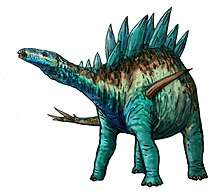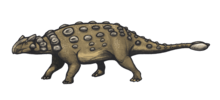Polacanthus
Polacanthus, deriving its name from the Ancient Greek polys-/πολύς- "many" and akantha/ἄκανθα "thorn" or "prickle",[3] is an early armoured, spiked, plant-eating ankylosaurian dinosaur from the early Cretaceous period of England.
| Polacanthus | |
|---|---|
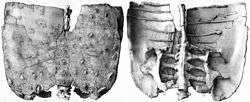 | |
| Hip armour of Polacanthus foxii | |
| Scientific classification | |
| Kingdom: | Animalia |
| Phylum: | Chordata |
| Clade: | Dinosauria |
| Order: | †Ornithischia |
| Family: | †Nodosauridae |
| Subfamily: | †Polacanthinae |
| Genus: | †Polacanthus Owen vide Anonymous, 1865 [1] |
| Type species | |
| †Polacanthus foxii Owen vide Anonymous, 1865[2] | |
| Synonyms | |
| |
In the genus Polacanthus several species have been named but only the type species Polacanthus foxii is today seen as valid.
Polacanthus was a quadrupedal ornithischian or "bird-hipped" dinosaur. It lived 130 to 125 million years ago in what is now western Europe.[4] Polacanthus foxii was named after a find on the Isle of Wight in 1865. There are not many fossil remains of this creature, and some important anatomical features, such as its skull, are poorly known. Early depictions often gave it a very generic head as it was only known from the rear half of the creature. It grew to about 5 metres (16 ft) long. Its body was covered with armour plates and spikes. It possibly was a basal member of the Nodosauridae.
Discovery and species

Polacanthus foxii was discovered by the Reverend William Fox on the Isle of Wight in 1865, at Barnes High at the southwest coast. Fox at first planned to have his friend Alfred Tennyson name the new dinosaur. Tennyson proposed Euacanthus Vectianus but this name was ultimately rejected.[5] In 1865, Fox in a lecture to the British Association reported on the find and let it be named Polacanthus foxii by Richard Owen, hereby circumventing the convention that an author does not name a taxon after himself.[6] The text of the lecture was more or less reproduced by him in an anonymous article in the Illustrated London News. This procedure caused some confusion as no corresponding 1865 publication by Owen exists. Some have therefore contended that Thomas Huxley in 1867 became the author of the name,[7][8] others give Fox, Owen or "Anonymous" as the author. The generic name is derived from Greek πολύς, polys, "many" and ἄκανθα, akantha, "thorn", in reference to the many spikes of the armour. The specific name honours Fox.
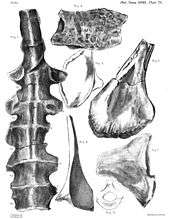
The holotype, BMNH R175, was found in a layer of the Upper Wessex Formation dating from the Barremian. It is an incomplete skeleton with the head, neck, anterior armour and forelimbs missing but including dorsal vertebrae, the sacrum, most of the pelvis, most of the left hindleg, the right thighbone, twenty-two tail vertebrae, ribs, chevrons, ossified tendons, a pelvic shield, twenty-two spikes and numerous ossicles. The skeleton was in 1881 studied by John Whitaker Hulke, while it was still in the possession of Fox. Hulke published the first detailed description of the find, noting that the specimen had badly deteriorated over the years, the dermal armour having almost fully fallen apart.[9] The same year Fox died, his collection was acquired by the British Museum of Natural History, including the Polacanthus fossil. This was then reassembled by preparator Caleb Barlow, painstakingly putting all the pieces together with Canada balsam, much to the wonder of Hulke who in 1881 had called this a hopeless undertaking. This allowed Hulke to redescribe the specimen in 1887, with a special attention to the armour arrangement.[10] In 1905, the specimen was again described by Franz Nopcsa who for the first time provided an illustration of the possible spike configuration.[11]
Later it was realised that, at one occasion at least, even before 1865 probable Polacanthus fossils had been found. In 1843 John Edward Lee reported the discovery on Wight of two armour specimens.[12]
Numerous specimens from Wight and Great Britain have since been referred to Polacanthus. These mostly consist of single bones or armour elements. A second partial skeleton, from which parts had been removed since 1876, was identified and fully excavated by Dr William T. Blows in 1979; it is also in the London Natural History Museum as specimen NHMUK R9293. It is the first specimen to show skull elements, neck vertebrae and unequivocal anterior armour.[8]
Several ankylosaurian remains from the Early Cretaceous of continental Europe have been referred to Polacanthus but none demonstrably share any unique traits, or autapomorphies, with its holotype.
Further species and genera

Apart from the two species today considered valid, several other species and genera have been named in relation to the Polacanthus material.
In 1924, Edwin Hennig named a Polacanthus becklesi, the specific name honouring collector Samuel Beckles, based on specimen BMNH R1926, a piece of an ilium associated with armour plates, found on Wight in the nineteenth century.[13] Today this is considered a junior synonym of P. foxii. It was assumed to be a different species because the armour is smoother on top, but this was likely caused by water erosion of the fossil.[8]
In 1987, William T. Blows claimed that the American Hoplitosaurus was a species of Polacanthus, renaming it into Polacanthus marshi.[8] Though this gained some popularity in the early 1990s,[14] today the identity is generally rejected.
In 1996, a Polacanthus rudgwickensis was named by Blows,[15] after a review of some fossil material found in 1985 and thought to have been Iguanodon, which was on display at the Horsham Museum in Sussex. The material, holotype HORSM 1988.1546, is fragmentary and includes several incomplete vertebrae, a partial scapulocoracoid, the distal end of a humerus, a nearly complete right tibia, rib fragments, and two osteoderms. P. rudgwickensis seems to have been about 30% longer than type species P. foxii and differs from it in numerous characters of the vertebrae and dermal armour. It is named after the village of Rudgwick in West Sussex and was discovered at a Rudgwick Brickworks Company quarry, at the quarry floor in gray-green marl beds of the Wessex Formation. Barremian age, approximately 124–132 million years ago. In 2015, Blows made it a separate genus Horshamosaurus.[16]
In 1971, Polacanthus foxii was by Walter Coombs renamed into Hylaeosaurus foxi.[17] This has found no acceptance, and the name is an invalid nomen ex dissertatione. Also it has been suggested that Polacanthus would be simply identical to Hylaeosaurus armatus. This was rejected by Blows in 1987, because of differences in age and anatomy.[8] A possible identity is hard to prove or disprove as there are few overlapping elements in their holotypes.[18]
In 1928, Nopcsa named a new genus and species Polacanthoides ponderosus, based on a number of syntypes: BMNH 2584, a left scapula found at Bolney which in 1841 by Gideon Mantell had been referred to Hylaeosaurus;[19] and BMNH R1106 en 1107, a tibia and humerus.[20] The new taxon has proven to be very problematic. Contrary to what Nopcsa assumed the tibia and humerus were not found at Bolney but on Wight.[8] This makes Polacanthoides a possible chimera, especially since their provenance from Wight makes it likely they belonged to Polacanthus.[8] Furthermore, the Wight specimens are not the original bones, which have been lost, but casts[8] which at best could have been used as plastotypes. The scapula belongs to an indeterminate thyreophoran.
In 1982 Justin Delair named a genus Vectensia, without providing a specific name, based on specimen GH 981.45, an armour plate. Like the holotype of Polacanthus it was found at Barnes High, but reportedly in an older layer, of the Lower Wessex Formation.[21] Blows in 1987 tentatively referred it to Polacanthus.[8]
Description

Polacanthus was a medium-sized ankylosaur. In 2010, Gregory S. Paul estimated its length at 5 meters (16 ft), its weight at 2 tonnes (2.2 short tons).[22] Thomas Holtz gave a lower estimation of 4 meters (13 ft) and 227-454 kg (500-1.000 lbs) in 2012.[4] Its hindlimbs are relatively long for an ankylosaur, with a right femur length of 555 millimetres with the holotype.
In 2011 Barrett e.a. indicated two possible unique traits, autapomorphies: the floor of the neural canal is deeply cut by a groove with a V-shaped transverse profile; the caudal spikes have triangular bases in side view and narrow points.[18]
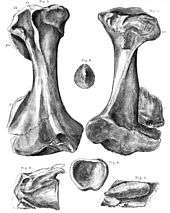
The subsequent describers have always dedicated much effort at restoring the armour configuration. Hulke understood that Polacanthus had a large "pelvic shield" or "sacral shield", a single fused sheet of dermal bone over its hips (sacral area) which perhaps was not attached to the underlying bone and decorated with tubercles. This feature is shared with other "polacanthine" (basal nodosaurids) dinosaurs such as Gastonia and Mymoorapelta. With the holotype, this shield is 108 centimetres wide and 90 centimetres long. It features four horizontal rows of larger keeled osteoderms per side, surrounded by smaller ossicles. These latter are sometimes completely fused to form flat armour plates. Hulke thought that on the tail there were two rows of keeled osteoderms per side. Of a set of spikes found with the fossil, he assumed they had adorned the sides of the rump.[10] A different arrangement was hypothesised by Nopcsa. He thought that both the tail and the front of the body including the neck featured two parallel rows of spikes, one per side. On the front body each row would have consisted of five spikes and he claimed that seven of these had been conserved with the fossil, five of the right side and two of the left. The tail rows would have consisted of twenty-two shorter pairs, fifteen spikes being still extant, eight of the left side and seven of the right.[11] As the spikes are asymmetrical their position can more or less be deduced. Blows in 1987 basically agreed with Nopcsa but also distinguished three spike types, a Type A, B and C, allowing him to classify additional fossil finds, which often differed from the holotype spikes in several details.[8]
Phylogeny
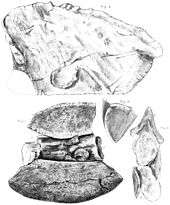

Fox in 1865 assigned Polacanthus to the Dinosauria, Huxley in 1870[23] and Hulke in 1881 assigned it to the Scelidosauridae. Its exact affinities were not well understood, until Coombs in 1978 placed in the Nodosauridae within a larger Ankylosauria.[24] In 1996 Kenneth Carpenter e.a. refined this to the Polacanthinae.[25] An alternative hypothesis, first suggested by Tracy Lee Ford in 2000,[26] is that there existed a clade Polacanthidae below the Nodosauridae + Ankylosauridae node.
A more conventional analysis from 2012,[27] in which Polacanthos foxii and P. rudgwickensis were not recovered as sister species, is shown by this cladogram:
| Nodosauridae |
| |||||||||||||||||||||||||||||||||||||||||||||||||||||||||||||||||||||||||||||||||||||||||||||||||||||||||||||||
See also
References
- Genus authority given as Huxley, 1867 in some sources, such as the second edition of The Dinosauria.
- Species authority given as Hulke, 1881 in some sources, such as the second edition of The Dinosauria.
- Liddell & Scott (1980). Greek-English Lexicon, Abridged Edition. Oxford University Press, Oxford, UK. ISBN 0-19-910207-4.
- Holtz, Thomas R. Jr. (2012) Dinosaurs: The Most Complete, Up-to-Date Encyclopedia for Dinosaur Lovers of All Ages,https://www.geol.umd.edu/~tholtz/dinoappendix/appendix.html
- Tennyson, H., 1897, "Note about Polacanthus", In: Alfred Lord Tennyson, A memoir by his son, The MacMillan Company, p. 23-24
- Fox W. (1865). "On a new Wealden saurian named Polacanthus". Report of the British Association for the Advancement of Science, 1865 for 1864, p. 56
- Huxley, T.H., 1867, "On Acanthopholis horridus, a new reptile from the Chalk Marl", Geological Magazine, 4: 65-67
- Blows W.T. (1987). The armoured dinosaur Polacanthus foxi, from the Lower Cretaceous of the Isle of Wight, Palaeontology. 30, 557–580
- Hulke, J.W., 1881, "Polacanthus foxii, a large undescribed dinosaur from the Wealden Formation in the Isle of Wight", Philosophical Transactions of the Royal Society of London, 172: 653–662
- Hulke, J.W., 1887, "Supplemental Note on Polacanthus Foxii, Describing the Dorsal Shield and Some Parts of the Endoskeleton, Imperfectly Known in 1881", Philosophical Transactions of the Royal Society of London. B 178: 169–172
- Nopcsa, F., 1905, "Notes on British dinosaurs. Part II. Polacanthus", Geological Magazine 2: 241-250
- Lee, J.E., 1843, "Notice of Saurian Dermal Plates from the Wealden of the Isle of Wight", Annals and Magazine of Natural History 11: 5-7
- Hennig, E., 1924, "Kentrurosaurus aethiopicus. Die Stegosaurier-Funde vom Tendaguru, Deutsch-Ostafrika", Palaeontographica Supplement 7: 101-254
- Pereda-Suberbiola, J., 1994, "Polacanthus (Ornithischia, Ankylosauria), a transatlantic armoured dinosaur from the Early Cretaceous of Europe and North America", Palaeontographica Abteilung A 232(4-6): 133-159
- Blows W.T. (1996) "A new species of Polacanthus (Ornithischia; Ankylosauria) from the Lower Cretaceous of Sussex, England". Geological Magazine, 133 (6): 671-682
- Blows, W.T., 2015, British Polacanthid Dinosaurs – Observations on the History and Palaeontology of the UK Polacanthid Armoured Dinosaurs and their Relatives, Siri Scientific Press, 220 pp
- Coombs, W. 1971. The Ankylosauria. Ph.D. thesis, New York: Columbia University
- Barrett, P.M. and Maidment, S.C.R. 2011. "Wealden armoured dinosaurs". In: Batten, D.J. (ed.). English Wealden fossils. Palaeontological Association, London, Field Guides to Fossils 14, 769 pp
- Mantell, G.A., 1841, "Memoir on a portion of the lower jaw of the Iguanodon and on the remains of the Hylaeosaurus and other saurians, discovered in the strata of Tilgate Forest, in Sussex", Philosophical Transactions of the Royal Society of London, 131: 131–151
- Nopcsa, F., 1928, "Palaeontological notes on Reptiles", Geologica Hungarica, Series Palaeontologica, tomus, 1, -Pasc. 1, p. 1-84
- Delair, J.B., 1982, "Notes on an armoured dinosaur from Barnes High, Isle of Wight", Proceedings of the Isle of Wight Natural History and Archaeological Society for 1980, 7(5): 297-302
- Paul, G.S., 2010, The Princeton Field Guide to Dinosaurs, Princeton University Press p. 229
- T.H. Huxley, 1870, "On the classification of the Dinosauria, with observations on the Dinosauria of the Trias", Quarterly Review of the Geological Society of London 26: 32-51
- W.P. Coombs, 1978, "The families of the ornithischian dinosaur order Ankylosauria", Palaeontology 21(1): 143-170
- K. Carpenter, J. I. Kirkland, C. Miles, K. Cloward, and D. Burge, 1996, "Evolutionary significance of new ankylosaurs (Dinosauria) from the Upper Jurassic and Lower Cretaceous, Western Interior", Journal of Vertebrate Paleontology 16(3, supplement):25A
- T.L. Ford, 2000, "A review of ankylosaur osteoderms from New Mexico and a preliminary review of ankylosaur armor", In: S.G. Lucas and A.B. Heckert (eds.), Dinosaurs of New Mexico. New Mexico Museum of Natural History and Science Bulletin 17, pp 157-176
- Richard S. Thompson, Jolyon C. Parish, Susannah C. R. Maidment and Paul M. Barrett, 2012, "Phylogeny of the ankylosaurian dinosaurs (Ornithischia: Thyreophora)", Journal of Systematic Palaeontology 10(2): 301–312
Bibliography
- Blows WT (2001). "Dermal Armor of Polacanthine Dinosaurs". In Carpenter, Kenneth (ed.). The Armored Dinosaurs. Indiana University Press. pp. 363–385. ISBN 0-253-33964-2.
- Carpenter K (2001). "Phylogenetic analysis of the Ankylosauria". In Carpenter, Kenneth (ed.). The Armored Dinosaurs. Indiana University Press. pp. 455–484. ISBN 0-253-33964-2.
| Wikispecies has information related to Polacanthus |
